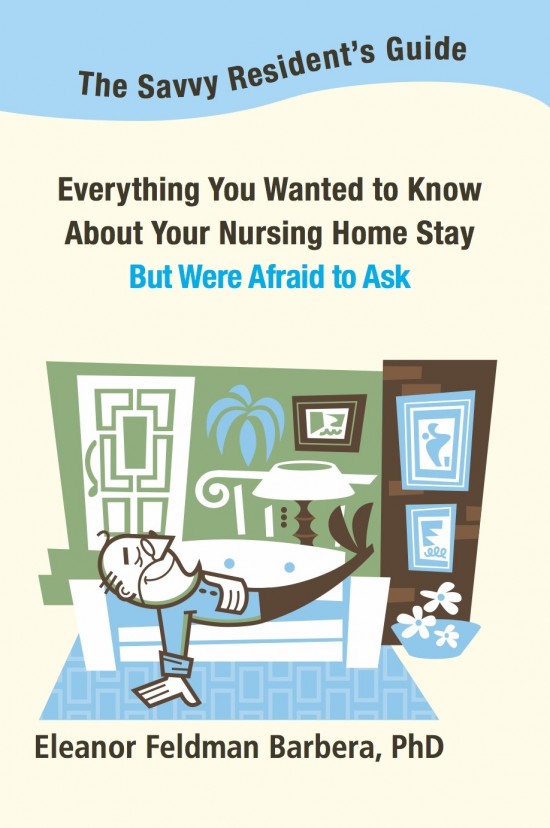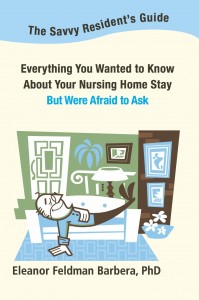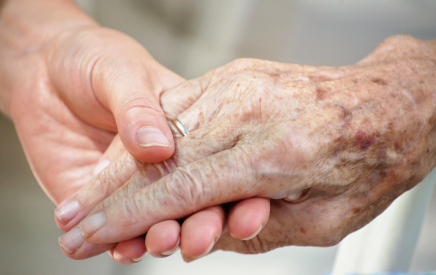Category: Engaging with families
Posted by Dr. El - December 7, 2016 - Books/media of note, Bullying/Senior bullying, Business Strategies, Common Nursing Home Problems and How Psychologists Can Solve Them, Customer service, Dementia, Engaging with families, McKnight's Long-Term Care News

The Savvy Resident’s Guide can help set reasonable expectations for your new residents and families, leading them to view their stays in a more favorable light. To see how, download a FREE Kindle version between December 7-9th and take advantage of Holidays Savings of 20% off bulk orders of 25 or more copies through Friday, December 23rd. Use the code MCKNIGHTS at checkout.
It’s like giving people 24/7 access to an experienced nursing home shrink who tells it like it is with gentle humor and answers every question before it’s asked. Put a copy in every rehab room and watch your customer satisfaction reviews improve!
For more great resources, read my latest article on McKnight’s Long-Term Care News:

Over the past year, I’ve been involved with several exciting long-term care-related projects that I can now tell you about. In the spirit of the season, I wanted to spread some good cheer with them*, and also offer a gift.
The first is a book entitled “Bullying Among Older Adults: How to Recognize and Address an Unseen Epidemic” by Robin P. Bonifas, to which I had the honor of contributing a chapter. This volume addresses the effects of bullying among seniors and outlines actions which facilities and communities can take to address the problem. It provides step-by-step assessment strategies and anti-bullying interventions that will increase staff awareness and improve day-to-day interactions.
In another publication, fellow geropsychologists Kelly O’Shea Carney and Margaret P. Norris have put their years of experience to paper in “Transforming Long-Term Care: Expanded Roles for Mental Health Professionals.” As I state in my review of their work, “The book will … appeal to long-term care policy strategists and facility managers looking for ways to reduce costs while improving care quality and staff turnover.” The book digs deeper into the Eldercare Method (which I earlier discussed here) and outlines ways in which long-term care can make better use of its consulting psychologists.
.
.
.
And finally, I’d like to offer the opportunity to download — through this Friday — a free Kindle version of my book, “The Savvy Resident’s Guide: Everything You Wanted to Know About Your Nursing Home Stay But Were Afraid to Ask.” This large-print guidebook provides essential facility-friendly information in an entertaining format for residents and family members regarding how to make the most of their time in a nursing home. (If you like it as much as I think you will, order here by Dec. 23 for a 20% discount for purchases of 25 or more. Use the code MCKNIGHTS upon checkout.)
*Full disclosure: I do not benefit financially from mentioning the resources of my colleagues or from any purchases of their products.
For the entire article, visit:

Posted by Dr. El - July 19, 2016 - Business Strategies, Communication, Customer service, Engaging with families, McKnight's Long-Term Care News, Motivating staff

Here’s my latest article on McKnight’s Long-Term Care News:

![]()
A friend of mine called me this week, upset about the racial tension making headlines in the news. We discussed what we could do as individuals to improve the situation.
“I called a friend of mine of a different race,” she said. “I told him we need to stay in touch right now, even if we’re busy.”
“My column this week is about the issue,” I responded. We talked about how differences are bridged in a healthcare environment.
In long-term care, we provide services to, and work with, individuals from backgrounds different than our own. Residents share rooms and break bread with types of people they may never have encountered more than superficially in their previous 80 years of life. Barriers recede when we come to know each other as people, yet it’s not always a smooth road.
Studies of racism in LTC
I’ve observed firsthand various culturally charged interactions — both positive and negative — and I wondered what types of racial challenges are common in long-term care.
I turned to the research to see what’s been studied formally and found that racism is observed in the following ways:
• Residents refusing care based on the racial or ethnic group of the caregiver, as noted in the New England Journal of Medicine article, “Dealing with Racist Patients.”
• Unpleasant work environments due to hearing racial remarks by family members or other workers, in “Racism Reported by Direct Care Workers in Long-Term Care Settings.”
• Nursing homes in areas with high poverty being more likely to close: “Why Medicaid’s Racism Drove Historically-Black Nursing Home Bankrupt.”
• The changing demographics of nursing homes due to people from minority groups having increased entrance to that level of care, but reduced access to privately paid home and community-based care such as assisted living: MedicareAdvocacy.org, “The Changing Demographics of Nursing Home Care: Greater Minority Access…Good News, Bad News.”
Increasing inclusion
While some of these problems are beyond the scope of any one LTC organization, there are ways in which the first two points can be addressed within our communities:
For the entire article, visit:

Posted by Dr. El - April 5, 2016 - Communication, End of life, Engaging with families


Aging advocate Carol Marak interviewed a group of eldercare experts (including me) regarding their experiences discussing death and dying with elders and their families. Her Huffington Post piece on the topic, excerpted below, suggests that yes, families — and many healthcare providers — are ready to have these important and necessary conversations.
Most people avoid the topics of aging and dying like the plague, don’t you agree? Erica Hollack, the author of “Live Well, Die Well,” doesn’t think so and argues the opposite. She attended a conference on end-of-life concerns and discovered that the 800 chairs set up for the workshop were not enough. The community came out in droves to hear the meaningful conversation in Spokane. So, as a whole, our culture may not be averse to talking about the end of life.
The Institute of Medicine (IOM) believes the time is right for a national dialogue to normalize the emotions on death and dying. They think that the social trends point toward a growing willingness to share stories about the end-of-life care and that it will help drive more family discussions. In the IOM consensus report, Dying in America, experts found that accessibility of medical and social services could improve a patient’s life at the end. But if people don’t discuss which medical care or social services they want or not, how will their wishes be known and carried out?
Since 70 percent of ill adults become unable to express their care preferences, the separation between what they want, and what they receive is significant and usually is the result of misinformation. Having end of life discussions can put a stop to the discrepancy. IOM believes we can do this through public education and engagement.
My family experienced several deaths over the years. However, one, in particular, sticks out. It was my brother-in-law’s. The medical and hospital staff followed his values, goals, and educated preferences. It made the process for everyone more relaxed and comfortable. The best of all, it created the sacred space for good-byes, forgiveness, and regrets. To this day, the family remains in awe of that unprecedented event.
There is power in stories. And by sharing them, it’s my hope to encourage meaningful dialogue between individuals and their families about beliefs, care, and choices. By sharing personal events and accounts, fear will dissipate. Death is a process to appreciate, and family members should spend the time reminiscing not deliberating over medical treatments.
The Institute of Medicine also recommends that service providers stimulate advance care planning between clients and medical teams so that the individuals can make informed choices based on one’s needs and to make them known. To unlock the narratives of death and dying so that others become more comfortable with the topic, I asked the Seniorcare.com Aging Council,
“Share one example of a family or person/client who experienced a higher quality of care as a result of having an open talk with loved ones?”
For the entire article, visit:
Posted by Dr. El - November 20, 2015 - Communication, Engaging with families, For Families, Tips for gifts, visits, Videos

With the start of the holiday season, it’s time for this perennial post from Dr. El:

‘Twas the Week Before Christmas…
And 83-year old Albertha assured me her family was planning to take her home for the holidays.
“Have you talked to them about it? Have they called the social worker to arrange a pass, and meds, and transportation?”
“No,” she replied, “but they’re coming to get me.”
‘Twas the week after Christmas, and Albertha was glum.
“They didn’t show up. I waited all day, but they didn’t come.”
Albertha spent Christmas day watching other people go out on pass and return, and seeing families arriving with food and gifts and smiles.
Now my residents and I start discussing the holidays a few weeks in advance, addressing wishes and practicalities, phoning families if needed, and getting the social worker involved. We set up a hierarchy of plans.
Plan A: Go home for the day.
Plan B: Go out to a wheelchair accessible restaurant with family.
Plan C: Have visitors come with food and go around the corner for coffee, if possible, just to get out.
Plan D: Stay in with visitors and food.
Plan E: Talk to family members on the telephone, discussing plans for a future visit, while sitting in a room festooned with cards and holiday decorations. Attend the nursing home holiday party.
Plan F: Have a small holiday gathering in the room with nursing home friends after the facility party.
Since then, my people know what to expect from the holidays, even if the expectation is that their family might not arrive as hoped.
Three tips from Dr. El for the holidays (click here or view below): http://youtu.be/8HTjVoKQmKo

MyBetterNursingHome.com
Posted by Dr. El - September 15, 2015 - Business Strategies, Communication, Customer service, Engaging with families, McKnight's Long-Term Care News, Resident/Family councils

Here’s my latest article on McKnight’s Long-Term Care News:

When families seek mental health treatment, it’s often because of a “problem child.” Family therapists consider this person to be the “identified patient” and recognize that the troubled individual is part of a family unit whose members all benefit from assistance.
By contrast, when a resident enters long-term care, we tend to focus solely on the needs of the resident, even though they’re almost always part of a family system that is being affected by their placement.
Oddly, we do this in spite of the fact that it’s frequently a family member who chooses the facility or community where the loved one will live.
If we consider that we’re admitting families rather than just the residents themselves, we’d recognize the need to provide family-centered care in addition to resident-centered care.
Instead, we repeatedly attend to the needs of families in a haphazard, reactive fashion. Those tense family meetings with the director of nursing and the administrator after the staff “mishandled” an interaction with a family member are more likely a lack of organizational attention to the needs of families and an absence of proper training than they are a reflection of staff error or of a “difficult” family.
Here are some ways to implement family-centered care:
1. Convey essential information to families about your facility or campus in a way that’s easy to access. If your website offers only platitudes about how you really care and then lists insurance options, you’re telling potential customers what you really care about and it isn’t them. Instead, turn your site into a 24/7 support kiosk, answering questions families commonly have about your community and helping them to be better caregivers and community members. Include, for example, information about their role in care plan meetings or how to help their loved one adjust to their new home. Add a list of resources they might want to consult. (My book, “The Savvy Resident’s Guide,” for example, is one way to offer information and soothe the frayed nerves of family members.)
2. Hold regular family meetings on topics that frequently affect them, such as caregiver stress, understanding dementia, and making the most of an off-campus pass (a great session to hold before the holiday season, hint, hint). Even though this may seem like yet another task to add to an already burdened staff, it will save time in the long run: Rather than answer the same questions individually, your staff can direct families to the meetings where questions can be discussed simultaneously and in depth.
3. Reach out to families during transitions in care, such as moving from an independent apartment to the care center in a continuing care retirement community.
For the entire article, visit:

Posted by Dr. El - September 2, 2015 - Business Strategies, Communication, Customer service, Engaging with families, McKnight's Long-Term Care News

Here’s my latest article on McKnight’s Long-Term Care News:

A study about rudeness in the medical journal Pediatrics got me thinking about the possible effects of rudeness in long-term care.
In “The Impact of Rudeness on Medical Team Performance: A Randomized Trial,” teams were subjected to rude comments by a supposed visiting medical colleague. For example, he suggested that the team members in the neonatal intensive care unit (NICU) “wouldn’t last a week” in his country.
Compared to the control group, teams that had been exposed to the rude comments had lower diagnostic and procedural performance scores.
Naturally, I wondered how this research might translate to senior living.
I’m sure I’m not the only person who has observed rudeness occurring in eldercare settings, whether it’s an administrator being curt with staff, nasty remarks between staff members, a discourteous statement to or from a resident, or a sharp comment by a family member.
To complicate matters, LTC teams are often multi-cultural. What’s considered reasonable for one culture may be deemed rude by another culture.
In addition, a comment can be interpreted differently depending on the ages and genders of the people involved. If an older female staff member compliments a young woman on her outfit, it can come across differently than if an older male staff member similarly compliments his young female colleague.
Long-term care is also very hierarchical. Doctors often “get away with” rude comments to nurses, as do administrators with underlings.
The research, however, suggests that nobody is getting away with anything. Rude statements negatively affect team performance in the NICU and, I suspect, in teams everywhere.
The good news is that the study found two behaviors reduced the impact of rudeness: information sharing lessened the negative impact of rudeness on diagnostic scores and help-seeking reduced the adverse impact of rudeness on procedural performance scores.
Here are some ways to address rudeness in LTC:
For the entire article, visit:

Posted by Dr. El - August 4, 2015 - Business Strategies, Common Nursing Home Problems and How Psychologists Can Solve Them, Engaging with families, McKnight's Long-Term Care News, Personal Reflections, Resident education/Support groups, Role of psychologists

Here’s my latest article on McKnight’s Long-Term Care News:

I hung up the phone with the managed care case reviewer. The patient in question was in her late 50s, with multiple sclerosis and other physical problems that had unexpectedly interfered with her ability to return home or even to sit comfortably in a wheelchair. Bed-bound, she was irritable with the staff and distressed about the changes in her life, and in financial circumstances that had resulted in this new insurance coverage.
“You can see her for another 30 days,” the case reviewer told me. “After that, I’ll have to send it to a second level review.”
I sat at the desk in the administration office, hyperventilating. What else would need to happen to this resident in order to get more than a month of treatment? An amputation? The death of her only child?
I took my mind to a better place:
I was in my office at the rehabilitation and care center reviewing the psychology calendar for the month:
• This week I’d shadow the east wing staff and focus on team building.
• My weekly open office hours with the staff had several appointments already filled to discuss conflicts with coworkers, finding better ways to interact with a difficult resident, and how an otherwise excellent worker could get to work on time.
• The topic for the August family group meeting was set: How to partner with the staff.
• The monthly staff training topic was planned to coordinate: How to work with families. Other trainings I had in mind were on facing challenges such as aggressive residents, understanding mental illness, dementia without medication and team management of end-of-life care, in addition to handling work/life balance, reducing stress, time management, and coping with loss.
• The data collection for my research project was progressing nicely. Copies of my book, “The Savvy Resident’s Guide,” had been distributed to the recreation therapists, who were using them to run discussion groups with the residents based on chapter topics such as “Working with the staff” and “Making the most of rehabilitation.” Residents were being measured on acquired knowledge, level of anxiety, conflicts with staff and participation in rehab.
For the entire article, visit:

Posted by Dr. El - July 8, 2015 - Communication, End of life, Engaging with families, McKnight's Long-Term Care News, Resident education/Support groups

Here’s my latest article on McKnight’s Long-Term Care News:

I walked into Mr. Hobart’s room, ready for my initial evaluation. He was a thin, graying man whose loose clothes hung in folds around him. He’d spent every day last week in chemo.
He spoke quietly, discussing his estrangement from his family and the good old days hanging out at the bar. None of his drinking buddies were around. He had no visitors.
Following our talk, I stopped at the nursing station. “What’s his prognosis?” I asked the nurse. “Not good,” she said. I paid a visit to the social worker and asked softly but very bluntly, “Is there a reason we’re medically torturing this man?” “We wanted to put him on hospice, but his brother won’t return my calls,” she told me. She promised to try again. By the next week, hospice services had been arranged. Mr. Hobart died five weeks later.
Unfortunately, this scenario is a fairly typical approach to end-of-life procedures in long-term care. The case highlights common end-of-life challenges in LTC facilities:
• No clear leadership within the treatment team regarding end-of-life care — Often team members, regarding this as a medical situation, expect that the physician will be addressing these issues with the resident and their family. The physician, on the other hand, may view dying as an emotional issue and expect that the social worker and other team members will be handling it.
• Lack of communication with the resident regarding end-of-life wishes — With no designated team member to broach the topic, residents often follow along with the care plan assuming they’re going to get better and that someone will tell them when they’ve reached the point where medical interventions are unlikely to help.
• Lack of communication with family members regarding prognosis and care decisions — Addressing treatment decisions and whether or not to consider hospice or palliative care is often a time-consuming series of discussions with family members and it needs to be handled with sensitivity. This can be difficult to manage in what’s become an ever fast-paced care environment.
• Aggressive medical treatments with very low likelihood of success — There are increasing numbers of medical treatments that can be performed, but questions arise about whether they should be: Is the treatment likely to help? Has the resident been properly informed of the risks and side effects of the treatment? Does the resident understand how it will affect his or her quality of life? Atul Gawande, MD addresses these questions eloquently and in detail in his book, “Being Mortal,” which I highly recommend.
• Late referral to hospice — Hospice is an excellent support for residents and their families. (Unlike in LTC facilities, the entire family –— not just the resident — is seen for treatment.) Most often, however, the referral for hospice services is made when the resident has days or weeks rather than months to live and much of the benefit of hospice services is lost.
As organizations that serve people who are ill and in the last years of their lives, we can create better deaths by improving end-of-life care.
• Establish an end-of-life care committee — Select and train members from various disciplines to be part of the committee. This specialized group can work with the resident’s ongoing treatment team to speak with the resident and their family members about end-of-life care and decision-making.
• Use available tools to discuss care decisions with residents and their families — Here are two resources to be aware of:
For the entire article, visit:

Portrait of multi generations Indian family at home. Asian people living lifestyle.
Posted by Dr. El - July 2, 2015 - Communication, End of life, Engaging with families, Resident care

Here’s an important article in the New York Times Opinionator Column by Ellen Goodman, one of the founders of The Conversation Project (which I’m about to investigate further). Note her comment that she expected her mother’s doctors to tell her what to do. The families of our residents are expecting the same from us.
I was 25 when I flew home for my father’s last birthday. His cancer had returned and he would die three months later at the age of 57. What I remember most about that weekend was the large rectangular gift box he opened. My mother had bought him a new suitcase.
I don’t know if that suitcase qualifies my family for the Denial Hall of Fame. There are so many contenders for that honor. But I’ve carried the psychic baggage over the years. I have never forgotten that image and how we lost a chance to say goodbye. I still wonder if my father was lonely in the silence that surrounded our inability to talk about what we all knew.
Decades later my mother began a long slow decline. By then, I was a newspaper columnist, a job that I often described as “telling people what you think.” I was professionally outspoken. But little had changed since my father’s death.
Yes, my mother and I talked about everything — but we didn’t talk about how she wanted to live toward the end. The closest we ever came to discussing her wishes was when she would see someone in dire straits and say, “If I’m ever like that, pull the plug.” But most of the time there is no plug to pull.
Gradually and painfully, my mother lost what the doctors call “executive function,” as if she were a C.E.O. fumbling with Excel spreadsheets, not a 92-year-old who couldn’t turn on the television or make a phone call. Eventually, she couldn’t decide what she wanted for lunch, let alone for medical care.
In some recess of my mind, I still assumed that death came in the way we used to think of as “natural.” I thought that doctors were the ones who would tell us what needed to be done. I was strangely unprepared, blindsided by the cascading number of decisions that fell to me in her last years.
For the rest of the article, visit:

Posted by Dr. El - June 5, 2015 - Communication, Engaging with families

I’m writing to you from my hotel room in Ontario, Canada today, where I’m finishing up some last minute details before heading out to give a training program on preventing senior bullying (iron suit — check!).
This week’s post comes from Abby Ellin, writing in the NYTimes Money column about the use of elder mediators to help families jointly and sanely make difficult decisions about elder care.
ROSIE, Therese and Linda McMahan were always close, but after their father died unexpectedly in 2011, they found their relationship strained.
They did not know what to do for their 84-year-old mother, Rose, and their brother, Paul, 53, who has cognitive disabilities and is in a wheelchair. The sisters tried to find an assisted-living home nearby, in the Boston area, but couldn’t. And so after many months, they decided that their mother and brother would move in with Rosie’s family in Amherst, Mass.
“We were all confused and upset about the situation,” said Rosie, 51, who is an educator and a counselor for teenagers. “We had so many questions. How much respite should my sisters offer me? Should Mom’s name stay on the deed of the house? Where will either of them go if I can’t keep taking care of them?”
“It was hard to figure it out,” said Therese, 50, a midwife in Somerville, Mass. “How do we make decisions? What do we all feel comfortable with? What are the guidelines we’re going to adhere to? Every conversation ended with someone crying or hanging up, or both.”
To help them navigate those difficult waters, they went to mediation to learn how to “stay in each other’s life and not have it be destructive,” as Rosie put it. “We wanted to stay connected as siblings, but if you don’t get someone else to help you out, you kind of fall prey to your childhood antics. A mediator makes a hard job a little easier.”
For the rest of the article, click below:

Big family together sisters and mother




















